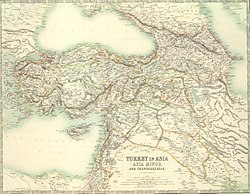
Back بنو آرتين Arabic Ərətna bəyliyi Azerbaijani ائرتنا بیلیغی AZB Eretnaoğulları Catalan Eretna German Beylicato de Eretna Spanish Eretnides French Eretnidi Italian ერეტნა Georgian Mîreketiya Eretna Kurdish
Eretnid dynasty | |||||||||||||||
|---|---|---|---|---|---|---|---|---|---|---|---|---|---|---|---|
| 1335–1381 | |||||||||||||||
 The Eretnids under Eretna | |||||||||||||||
| Status | Sultanate | ||||||||||||||
| Capital | Sivas and Kayseri | ||||||||||||||
| Religion | Islam | ||||||||||||||
| Government | Monarchy | ||||||||||||||
| Sultan | |||||||||||||||
• 1335–1352 | Ala al-Din Eretna | ||||||||||||||
• 1380–1381 | Muhammad II Chelebi | ||||||||||||||
| History | |||||||||||||||
• Established | 1335 | ||||||||||||||
• Independence | 1343 | ||||||||||||||
• Disestablished | 1381 | ||||||||||||||
| |||||||||||||||
| History of Turkey |
|---|
 |
| Timeline |
|
|
The Eretnids (Turkish: Eretna Beyliği) were a dynasty that ruled a state spanning central and eastern Anatolia from 1335 to 1381. The dynasty's founder, Eretna, was an Ilkhanid officer of Uyghur origin, under Timurtash, who was appointed as the governor of Anatolia. Some time after the latter's downfall, Eretna became the governor under the suzerainty of the Jalayirid ruler Hasan Buzurg. After an unexpected victory at the Battle of Karanbük, against Mongol warlords competing to restore the Ilkhanate, Eretna claimed independence declaring himself the sultan of his domains. His reign was largely prosperous earning him the nickname Köse Peyghamber (lit. 'the beardless prophet').
Eretna's son Ghiyath al-Din Muhammad I, although initially preferred over his older brother Jafar, struggled to maintain his authority over the state and was quickly deposed by Jafar. Shortly after, he managed to restore his throne, although he could not prevent some portion of his territories from getting annexed by local Turkoman lords, the Dulkadirids to the south, and the Ottomans to the west. In 1365, when he had recently put an end to the revolt of his vizier (chief minister), he was murdered by his emirs (vassals) in Kayseri, the capital.
His 13-year-old son, Ala al-Din Ali, was largely not allowed to interfere in administrative matters by the local emirs, who had been enjoying a substantial degree of autonomy since Eretna's demise. Ali lacked necessary skills of governance and was described to have only cared for personal pleasures. The state's borders continued to shrink, and the capital temporarily came under Karamanid control. Kadi Burhan al-Din rose to power as the new vizier and further dispatched Ali to command several largely unsuccessful campaigns. Ali died of the plague in August 1380 amidst one of those expeditions. The fourth Eretnid sultan, Muhammad II Chelebi was 7 years old when his father died. His regent Burhan al-Din toppled him in less than a year and proclaimed himself as the new sultan by January 1381, ending the Eretnid dynasty's political presence.
There is a scant number of surviving buildings and literary works identified with the rule of the Eretnids. This contrasts with the neighboring contemporary states, who left a greater architectural legacy.